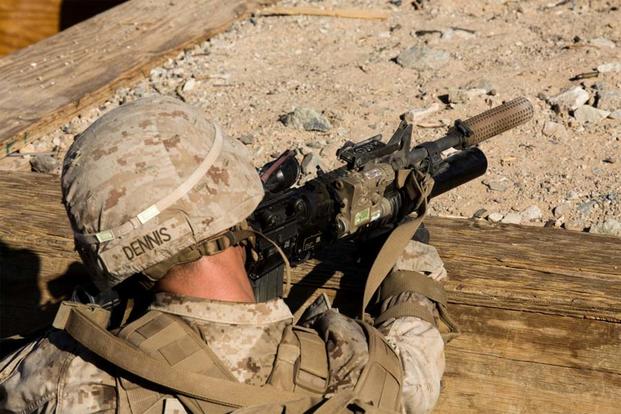In a series of experiments this year, units from 2nd Marine Division will be silencing every element of an infantry battalion -- from M4 rifles to .50 caliber machine guns.
The commanding general of 2nd Marine Division, Maj. Gen. John Love, described these plans during a speech to Marines at the Marine Corps Association Ground Dinner this month near Washington, D.C.
The proof-of-concept tests, he said, included Bravo Company, 1st Battalion, 2nd Marines, which began an Integrated Training Exercise pre-deployment last month at Marine Corps Air-Ground Combat Center Twentynine Palms.
"What we've found so far is it revolutionizes the way we fight," Love told Military.com. "It used to be a squad would be dispersed out over maybe 100 yards, so the squad leader couldn't really communicate with the members at the far end because of all the noise of the weapons. Now they can actually just communicate, and be able to command and control and effectively direct those fires."
Chief Warrant Officer 5 Christian Wade, the division's gunner, or infantry weapons officer, said the Lima companies in two other battalions -- 3rd Battalion, 6th Marines, and 3rd Battalion, 8th Marines -- now had silencers, or suppressors, on all their rifles, including the M27 infantry automatic rifles. All units are set to deploy in coming months. The combat engineer platoons that are attached to these units and will deploy with them will also carry suppressed weapons, he said.
Suppressors work by slowing the escape of propellant gases when a gun is fired, which drastically reduces the sound signature. Used by scout snipers and special operations troops to preserve their stealth, the devices are also valuable for their ability to minimize the chaos of battle, enabling not only better communication but also improved situational awareness and accuracy.
"It increases their ability to command and control, to coordinate with each other," Wade told Military.com. "They shoot better, because they can focus more, and they get more discipline with their fire."
The noise of gunfire can create an artificial stimulus that gives the illusion of effectiveness, he said. When it's taken away, he explained, Marines pay more attention to their shooting and its effect on target.
"They've got to get up and look, see what effect they're having on the enemy because you can't hear it," he said.
He added that suppressors were already in common use by near-peer militaries, including those of Russia and China.
Wade said he is working on putting suppressors on the Marines' M249 light machine gun and M240G medium machine gun, using equipment from Marine Corps Forces Special Operations Command. The third and final objective will be the suppression of the .50 caliber heavy machine gun, he said.
As the units conduct training and exercises with suppressors, 2nd Marine Division is collaborating with the Marine Corps Warfighting Lab to collect and aggregate data. Weapons with suppressors require additional maintenance and cleaning to prevent fouling, and the cost, nearly $700,000 to outfit an infantry battalion, might give planners pause.
But Wade said he will continue to gather data for the next year-and-a-half, following the units as they deploy. And he expects the idea to have gained significant traction among Marine Corps leadership by then, he said.
"When I show how much overmatch we gain … it will have sold itself," he said.
-- Hope Hodge Seck can be reached at hope.seck@military.com. Follow her on Twitter at@HopeSeck.
Related Video:
Want to know about the M4 Carbine? Here are a couple quick bullet point facts in this episode of "Bullet Points: M4 Carbine." Watch the video.




























